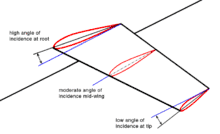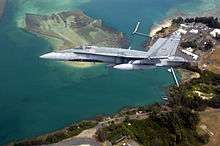Washout (aeronautics)
Washout is a characteristic of aircraft wing design which deliberately reduces the lift distribution across the span of an aircraft’s wing. The wing is designed so that the angle of incidence is greater at the wing roots and decreases across the span, becoming lowest at the wing tip. This is usually to ensure that at stall speed the wing root stalls before the wing tips, providing the aircraft with continued aileron control and some resistance to spinning. Washout may also be used to modify the spanwise lift distribution to reduce lift-induced drag.


Design considerations
Washout is commonly achieved by designing the wing with a slight twist, reducing the angle of incidence from root to tip, and therefore causing a lower angle of attack at the tips than at the roots. This feature is sometimes referred to as structural washout, to distinguish it from aerodynamic washout.
Wingtip stall is unlikely to occur symmetrically, especially if the aircraft is maneuvering. As an aircraft turns, the wing tip on the inside of the turn is moving more slowly and is most likely to stall. As an aircraft rolls, the descending wing tip is at higher angle of attack and is most likely to stall. When one wing tip stalls it leads to wing drop, a rapid rolling motion. Also, roll control may be reduced if the airflow over the ailerons is disrupted by the stall, reducing their effectiveness.
On aircraft with swept wings, wing tip stall also produces an undesirable nose-up pitching moment which hampers recovery from the stall.
Washout may be accomplished by other means e.g. modified aerofoil section, vortex generators, leading edge wing fences, notches, or stall strips. This is referred to as aerodynamic washout. Its purpose is to tailor the spanwise lift distribution or reduce the probability of wing tip stall.
Winglets have the opposite effect to washout. Winglets allow a greater proportion of lift to be generated near the wing tips. (This can be described as aerodynamic wash-in.) Winglets also promote a greater bending moment at the wing root, possibly necessitating a heavier wing structure. Installation of winglets may necessitate greater aerodynamic washout in order to provide the required resistance to spinning, or to optimise the spanwise lift distribution.
The reverse twist (higher incidence at wingtip), wash-in, can also be found in some designs though less common.
Applications
In gliders, washout can be used to stabilize the plane during transition from high speed launch to low speed gliding.
The Cessna 172 has washout in its wings to provide stability and aileron control during stalls, as washout causes stalling to begin from the wing root. [1]
The CF-18 Hornet has approximately 4 degrees of washout built into its wings.[1]
See also
- Wing twist
- Stall (flight)
- Spin (flight)
References
- "How Wing Washout Makes Your Airplane More Stable". www.boldmethod.com. Retrieved 2020-06-09.